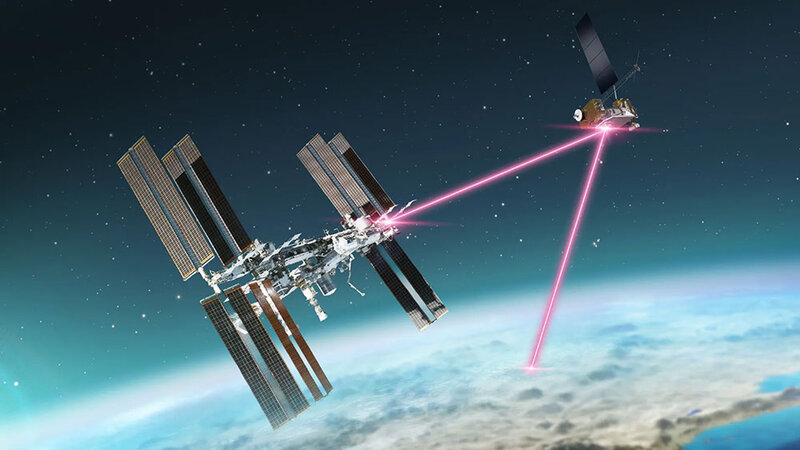Space technology
Space Communication
How Infrared Lasers are changing the comms game.
In the big, deep, black void of space surrounding our planet, humans need a way of reliably communicating with one another as we explore uncharted territory. The best solution we currently have for this is radio frequency-based satellite communications. However, as technology continues to advance at an incredible pace, so does the need for more efficient and secure means of transmission. This is what has prompted the growing interest and investment in laser communication over recent years - a topic that we shall explore its potential in this article.
A refresher on Infrared Laser Technology
Infrared laser technology is a type of energy that is not visible to the naked eye but can be harnessed and utilized for various applications. It falls within the electromagnetic spectrum, with wavelengths longer than those of visible light.
The concept of using infrared radiation for practical purposes was first introduced in the early 1800s by Sir William Herschel, a British astronomer. He discovered that when sunlight passes through a prism, there is an increase in temperature beyond the red end of the visible spectrum. This led to further experiments and eventually the development of infrared laser technology.
Infrared lasers can also handle higher bandwidths, making them better suited for transmitting large amounts of data quickly.
How it works
Infrared lasers work by emitting a beam of light at a specific wavelength within the infrared range, typically between 700 nanometers (nm) to 1 millimeter (mm). This invisible light is then absorbed by target materials in the form of heat, causing a change in their properties.
Infrared lasers are typically classified into three types based on their wavelength: near-infrared (NIR), mid-infrared (MIR), and far-infrared (FIR). Each type has its own unique characteristics and applications.
The difference between Infrared Laser and Radio Frequency communication technology
Infrared technology is often compared to radio frequency (RF) communication technology, as they both use electromagnetic radiation for transmission. However, there are some key differences between the two.
One of the main differences is that infrared light has a shorter wavelength and higher frequency - by a factor of roughly 100,000 - than radio waves. This gives infrared lasers the capacity to transmit data at faster rates and with more precision than RF. Infrared lasers can also handle higher bandwidths, making them better suited for transmitting large amounts of data quickly.
Another difference between the two technologies is their method of transmission. Infrared technology uses light beams to transmit information through free space or fiber optic cables. RF technology, on the other hand, uses radio waves to transmit information through the air or via wired connections.
Because infrared lasers have a more focused and directional transmission compared to RF, which can scatter and interfere with other signals in their path, they're ideal for line-of-sight communication. Places where there are no obstructions between the transmitter and receiver such as outer space stand to benefit greatly from infrared's combined speed and precision.
Infrared lasers have a more focused and directional transmission compared to RF, which can scatter and interfere with other signals in their path, they're ideal for line-of-sight communication.
The promise of Laser Optical Communications
Infrared lasers have the potential to drastically transform humanity's capabilities both on Earth and in outer space. Beyond the planetary atmosphere, scientists see several opportunities that laser optical communications could bring, such as enabling faster and more efficient communication between spacecraft and ground stations. It could also revolutionize the way we send data from one planet to another, opening up new possibilities for space exploration.
Today though, the most practical benefit of laser optical communications lies in its versatility. Where existing radio frequency communication technology struggles with austere environments such as deserts, forests, or mountainous regions, infrared laser technology thrives. It can easily penetrate through these obstacles and maintain a stable connection over long distances.
Not only that, but infrared lasers are inherently more secure than traditional radio frequency communication. The narrow beam size makes it difficult for potential eavesdroppers to intercept or jam the signal, ensuring a higher level of data security for high-stakes missions.
A significantly increased bandwidth compared to traditional RF technology also means that more data can be transmitted in a shorter amount of time. This has huge implications for space exploration, where large amounts of data need to be sent back and forth between spacecraft and Earth.
Infrared laser can easily penetrate through obstacles and maintain a stable connection over long distances.
Challenges presented by the use of laser optics in Space Communication
While there are certainly many advantages to be reaped by deploying laser optics in space communication projects, experts warn that we're still far off from such a normality. This technology's very benefits, specifically the small beam size that makes laser optics so secure, can also present challenges in the environment of outer space.
One major challenge is maintaining a stable connection between the spacecraft and Earth. The atmosphere on Earth constantly moves, causing turbulence that can disrupt and scatter infrared laser signals. This can result in a loss of data or even a complete disconnection between the spacecraft and ground stations.
Ultra-precise Pointing, Acquisition, and Tracking (PAT) is further necessary for laser communication to be successful. In traditional radio frequency (RF) communications, the signal can be transmitted and received over a larger area, making it easier for the spacecraft and ground station to maintain contact with each other. However, with laser optics' narrow beam, any slight movement or deviation can result in a loss of connection.
